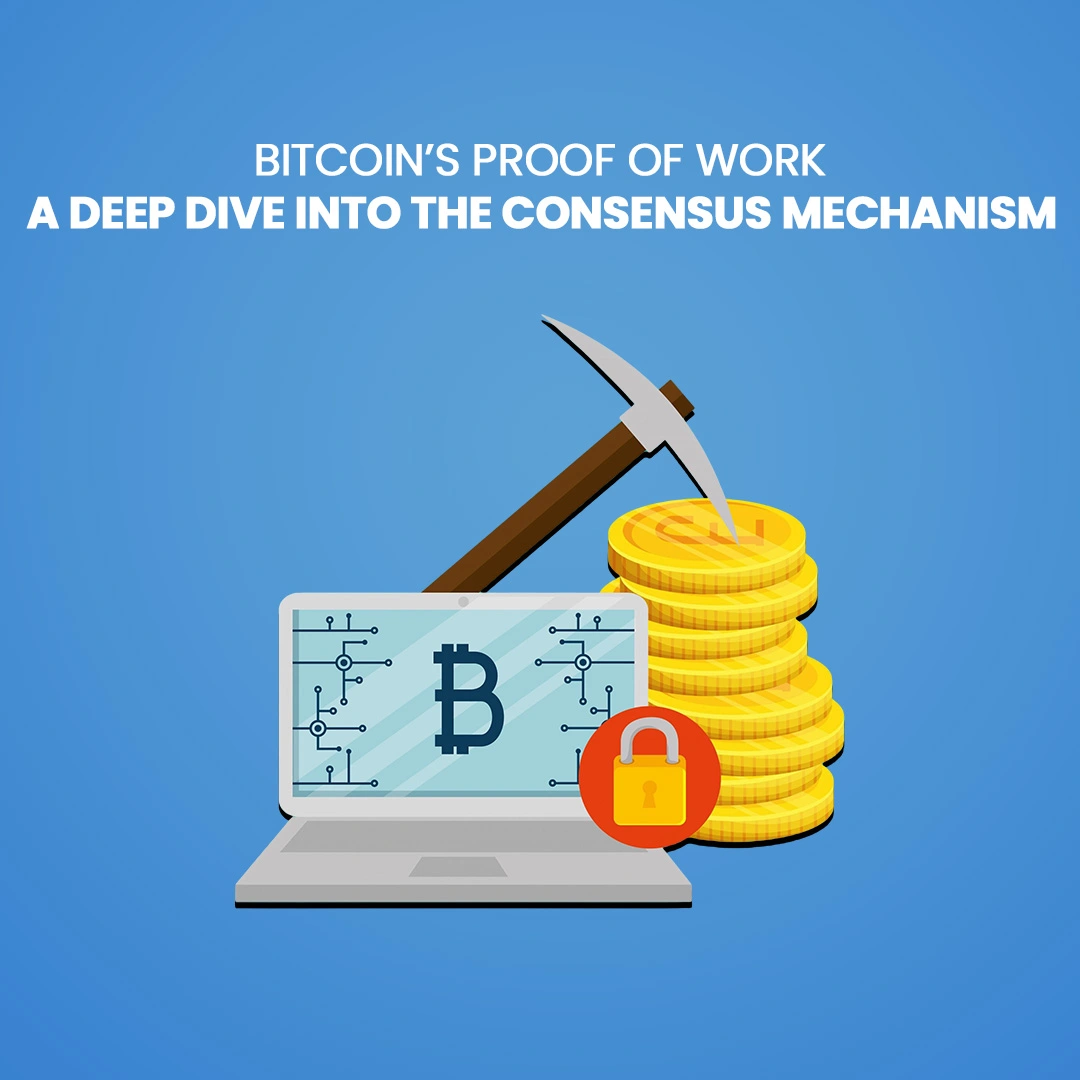

Proof of Work, Bitcoin’s Consensus Mechanism
The traders who are enthusiastic about understanding the technicalities and peculiarities behind Bitcoin’s proof of work ought to know that it is all about credibility and authenticity. The latchkey to Bitcoin’s success as the prototype of decentralized finance lies in its exclusive style of establishing trust in a world devoid of trustworthiness or conviction.
Bitcoin is known to employ a decentralized system that runs autonomously, in contrast to conventional financial systems that depend on central authorities like banks or governments to validate transactions. However, this independence necessitates a full-proof system to guarantee that transactions are safe, authentic, and unchangeable. This is where Proof of Work (PoW) comes into play and is known to be useful.
Proof-of-work (PoW) is the foundation of the Bitcoin blockchain. This blockchain ensures that every transaction is authentic and is confirmed by network users rather than a single authority, unlike a traditional ecosystem.
If you want to understand the basics of trading, here’s a beginner’s paradise. However, in this article, we are bringing to you an extensive look into the definition of Proof of Work, how it empowers Bitcoin, its implications for the larger cryptocurrency community, and all the intensifying discussions about its viability and future.
What exactly is POW?
Bitcoin is a Decentralized network
like Bitcoin use Proof of Work (POW), a consensus technique, to verify transactions and protect the network. To put it simply, it is a technique that enables network users or miners to resolve challenging mathematical problems. The next block of transactions is added to the blockchain by the miner who solves the problem first. The miner is rewarded with freshly created bitcoins as well as any transaction fees related to the block.
Technically, this process is a resource-intensive and competitive process. These puzzles are generally solved by miners using phenomenally powerful computers, guaranteeing that creating new blocks takes a lot of work and effort—thus the term “Proof of Work.” Although the puzzle itself is difficult to solve, once it is, other network users can instantly authenticate the solution.
Why is it named Proof of Work?
Although Bitcoin made PoW popular, the idea behind it existed for decades before cryptocurrencies. PoW was created in the early 1990s to counteract denial-of-service (DoS) attacks and spam emails. The concept was straightforward: spammers and attackers would be discouraged if sending an email or request took some computational work, as it would become too expensive for them to spam systems with instructions.
An early proof-of-work system called Hashcash, developed by Adam Back in 1997, required email senders to calculate a value before sending an email. By making sure that each email took a minimal amount of calculation, this decreased spam. In the 2008 Bitcoin white paper, its author, Satoshi Nakamoto, expanded on this idea and modified it for use with blockchain technology.
The nitty-gritties behind Bitcoin’s Proof of Work
Hashing, a cryptographic technique at the core of PoW, is like solving a mathematical puzzle. It converts input data—a block of transactions—into a fixed-length string of characters called a hash. Miners have to determine a particular input, or node, that generates a hash that satisfies the difficulty requirements set by the Bitcoin network.
Consider rolling a 100-sided dice until you get a number that begins with a particular set of digits as an illustration. Numerous attempts are necessary for this process, and each one needs time and processing power. Similar steps are taken by miners, who experiment with various inputs until they discover one that yields a hash with the appropriate amount of leading zeros (the difficulty objective).
The Purpose of Hashing
Verification of Work
By performing the hash function themselves, other nodes in the network can rapidly confirm the solution when a miner discovers a hash that meets the difficulty target. The new block gets added to the blockchain if the hash satisfies the necessary difficulty.
Immutability
It is very difficult to alter a block once it has been added to the blockchain. Any change made to a single transaction would affect the block’s hash as a whole, indicating to the rest of the network that tampering had taken place. This produces an unchangeable ledger that is difficult to modify.
What is the connection between Proof of Work (PoW) and mining and validation?
In order to maintain the security and fairness of the Bitcoin system, Proof of Work (PoW) involves both mining and validating.
The main goal of mining is to solve challenging riddles. In order to answer these challenges, miners expend a lot of energy and computing resources. They put forth the effort to add new transactions (blocks) to the blockchain; this is the “evidence” of their labor.
Validation is similar to the final check. Validators ensure that everything in the new block is accurate and complies with the rules, but they do not solve the puzzles. It is similar to editing a book after adding a new page.
Once the puzzle has been resolved, the miner publishes the validated transactions to the whole network in a new block. After that, more miners and network nodes will confirm that the block’s hash satisfies the required level of difficulty. The block is put on the network, and the miner receives Bitcoin if most miners approve. A continuous and secure chain of blocks is produced by repeating this process approximately every ten minutes.
What’s the significance of POW in securing Bitcoin?
Decentralized and Trust-independent system
The decentralized nature of Bitcoin is one of its distinguishing features. Bitcoin uses a decentralized network of miners to monitor and validate transactions, in contrast to traditional financial systems that rely on a central authority (such as a bank). By guaranteeing that anyone with sufficient processing power can engage in mining, PoW makes this decentralization possible rather than depending on a single, reliable party to validate transactions.
The appeal of Bitcoin is largely due to its trustless mechanism. No third party must be involved in a transaction, and no one party has the power to change the blockchain to its advantage. Rather, miners, who are dispersed throughout the world, collaboratively validate transactions and guarantee network security.
Avoiding Double-Spending
PoW addresses a number of important issues, including double-spending. Attempting to spend the same Bitcoin more than once is known as double-spending. By centrally authenticating transactions, banks or payment processors in traditional financial systems avoid double-spending. PoW, on the other hand, makes sure that a transaction is essentially irreversible after it has been confirmed, eliminating the chance of double-spending in a decentralized system like Bitcoin.
A miner would have to rerun all the PoW for each block after the modified one in order to change previous transactions due to the blockchain’s immutability, which is guaranteed by PoW. Double spending is therefore not just extremely rare but also technologically impractical.
What are the known difficulties in mining, and what are the rewards?
Adjusting the Difficulty of Mining
The most known challenge about mining is the difficulty of having a valid hash.
Every 2,016 blocks, or roughly every two weeks, the Bitcoin network modifies the mining difficulty to maintain a constant block creation duration of about 10 minutes.
This modification is depending on how much processing power miners are using overall.
The challenge gets more difficult and takes more effort to find a valid hash when more miners join the network and the total hash rate rises. On the other hand, the difficulty drops as miners quit the network.
Block rewards and halving
No matter how many miners are actively using the network, Bitcoin’s block production is guaranteed to stay constant because of these dynamic difficulty adjustments.
Miners received 50 bitcoins for each block they successfully mined when Bitcoin first launched in 2009.
Every 210,000 blocks, or roughly every four years, this award is set to be cut in half. In 2012, the reward was cut in half for the first time, to 25 bitcoins per block.
The most recent halving, which took place in 2020, decreased the payout to 6.25 Bitcoins.
Since there are only 21 million Bitcoins in circulation, this halving event is essential to the deflationary character of the cryptocurrency.
The mechanism guarantees that all 21 million Bitcoins will be mined by about 2140 by gradually decreasing the block reward, which creates scarcity and the possibility of future value growth.
Transaction Fees as a Potential Incentive
Transaction costs may grow more crucial in encouraging miners to keep protecting the network as block rewards decline.
Miners receive these fees in addition to the block reward, which users pay to prioritize their transactions.
Transaction fees will eventually take over as the primary reason for miners to keep working as the block reward gets closer to zero.
Sustainability and Energy Consumption issues in solving crypto puzzles for POW
What is the energy consumption of Bitcoin?
The energy usage of Bitcoin is one of the most controversial topics concerning it. It takes a lot of energy to solve the cryptographic riddles that PoW requires.
According to some estimations, mining Bitcoin actually uses as much energy each year as some small nations. The network’s overall energy consumption rises as more miners join.
This has drawn a lot of criticism, especially from the environmentalists who contend that Bitcoin’s carbon footprint is unsustainable given international attempts to mitigate climate change.
Effects on the Environment
Understanding the environmental effects of Proof of Work (PoW) is indeed very important, especially at a time when people are participating in eco-conscious drives.
The effects of POW on the world transcend beyond its energy use. The usage of application-specific integrated circuits, or ASICs, which are specialized mining equipment designed especially for cryptocurrency mining, is a major contributing element.
Although these computers are quite effective at solving the challenging puzzles that PoW demands, they soon become outdated as more potent, newer models are created.
Significant electronic trash is produced by this quick turnover, which worsens the environment.
Furthermore, especially in areas where fossil fuels continue to be the dominant source of energy, the requirement for continuous electricity to run mining rigs frequently leads to higher greenhouse gas emissions.
To sum it all up, a trader or an aspiring investor to trade cryptocurrencies must have a solid understanding of PoW, its effects on the environment, and the related topics like network security and mining gear.
Understanding PoW thoroughly helps traders understand the security and limitations of networks such as Bitcoin.
You, as a trader, may make wise choices and understand the intricacies of decentralized finance by being aware of the fundamentals of blockchain operations.
When traders acknowledge both the advantages and downsides of PoW, they are able to take a more ethical and insightful approach to trading and investing in blockchain technology.
FAQs
Bitcoin uses a consensus process called Proof of Work to secure and validate transactions on its blockchain. Miners compete to solve challenging mathematical puzzles; the first person to do so adds the subsequent block to the chain and receives Bitcoin prizes.
Miners must utilize powerful computers to solve intricate riddles in order to mine bitcoin, which uses a lot of electricity. Energy usage increases to meet demand as more miners join the network and mining becomes more challenging.
A 51% attack happens when one party has more than 50% of the mining power on the network, giving them the ability to change the blockchain. On a big network like Bitcoin, PoW makes this almost difficult by needing a lot of processing power, which makes such an attack very expensive and implausible.
In regions where fossil fuels are utilized for electricity, PoW mining can result in greenhouse gas emissions due to its high energy requirements. The environment is further impacted by the short lifespan of mining equipment, like ASICs, which adds to digital trash.







